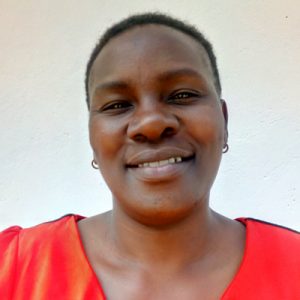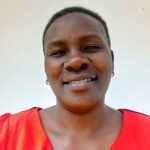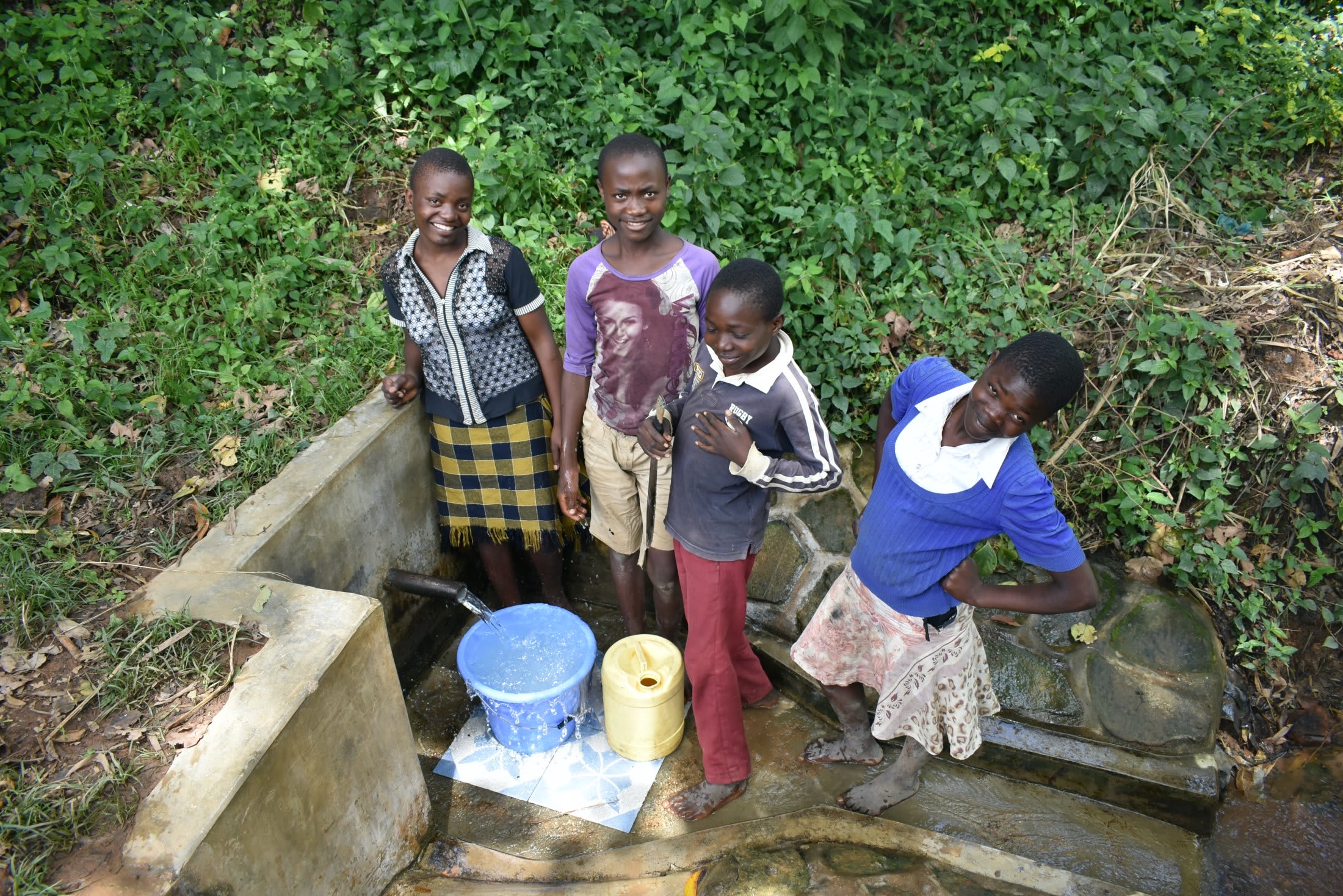Project Updates
July, 2020: Through Their Eyes: COVID-19 Chronicles with Philip Omukiti
This post is part of a new series by The Water Project meant to highlight the perspectives and experiences of the people we serve and how the COVID-19 pandemic is impacting them. We invite you to read more of their stories here.
"Staying indoors is not my thing...It seems I have a lot of time on my hands," said 31-year-old teacher Philip Omukiti plainly.
After several months of lockdowns, restrictions, curfews, and stress in his hometown of Mungakha, Kenya, it is easy to find empathy in Philip's statement as so many people around the world are facing similar challenges.

Philip Omukiti stands outside his home in Mungakha, Kenya.
The COVID-19 pandemic has changed or brought to a halt many familiar routines, not least of which is sending children to school. In Kenya, all primary and secondary schools have been closed since March, and they do not plan to reopen until at least January 2021.
Not all schools and homes in Kenya have the resources or ability to move classes online. Consequently, for many pupils and teachers alike, this pandemic period has been one of frustration and stagnation. Philip, who ordinarily works as a teacher, knows this story well.
Philip is a member of the water user committee for Asena Spring, which he depends on for all of his daily water needs. Our team recently visited Mungakha to conduct a COVID-19 prevention training (read more about it below!) and monitor their water point. Shortly after, we returned to check in on the community, offer a COVID-19 refresher training, and ask how the pandemic is affecting their lives.

Philip (left) observes social distancing while attending a COVID-19 sensitization training in June.
It was during this most recent visit that Philip shared his story of how the coronavirus has impacted his life both personally and professionally.
Team member David Muthama met Philip outside his home to conduct the interview. Both David and Philip observed social distancing and other precautions throughout the visit to ensure their health and safety. Their questions and answers have been edited for clarity and length.

Philip stands at the entry to his homestead to greet David.
What is one thing that has changed in your community since the protection of Asena Spring?
"I am confident that I am taking safe, clean water unlike before when the spring was wide open, exposed to frogs and tadpoles. I am confident and happy I have a source of clean water I can depend on."
How has having a clean water point helped you through the pandemic so far?
"There is plenty of clean water, and now I am able to wash hands, wash utensils, and even sanitize my furniture and other touchable items I use every day, including - most importantly - our clothes."

Philip fetches water at Asena Spring.
Since the outbreak of COVID-19 in Kenya, has fetching water changed for you because of restrictions, new rules, or your concerns about the virus?
"I am a trained teacher by profession, and I would wake up and go to work, not having anything to do with water at the spring. But since the pandemic, schools closed, and I have been going to the spring to fetch water or do some cleaning. After the training by your team, I have observed that people are washing hands at the water point and doing social distancing, which I also do."


Philip washes his hands with soap and water from Asena Spring using a leaky tin handwashing station he set up at home.
How has COVID-19 impacted your family?
"Staying indoors is not my thing. I can't go to work, there is no socialization, and people are not interacting as before. As my profession - I am a teacher - suggests, I am a guy who loves the social set-up. And for the children, life has become unbearable since they are used to school life."
"On the positive side, the pandemic has helped us as a family as most of us are now back at home since there are no jobs. Some of us had not met for a long time, but with the lockdown, we've had time to socialize and catch up on life."

Philip sits with some of his nieces and nephews who are home from school due to the pandemic.
What other challenges are you experiencing due to the COVID-19 pandemic?
"Traveling has become a challenge as well as having an insufficient food supply. Getting money has become a challenge since jobs like coaching are no longer available, which has brought a lot of idleness and wastage of time."
"I miss my teaching job, I miss the school, and I miss the students. It seems I have a lot of time on my hands."

Philip spends some of his extra time keeping a close eye on would-be weeds in his vegetable garden near the spring.
What hygiene and sanitation steps have you and your community taken to stop the spread of the virus?
"We are adhering to social distancing, handwashing with soap for at least 20 seconds, wearing masks anytime we leave the home, and strictly avoiding public areas such as political forums and other gatherings like funerals."

Philip shows his mask.
Have any COVID-19-related restrictions been lifted since they began in Kenya?
"Yes."
What restriction were you most excited to see lifted already?
"Opening of the partial lockdown of counties and the extension of curfew hours."
What restriction are you still looking forward to being lifted?
"Meetings, because I can't send off our beloved ones in burials. And because for church, certain age groups have been barred from going, and these age groups are usually the most active in church activities."

Philip brought all of his nieces and nephews along to the spring to help fetch water for their families.
When asked where he receives information about COVID-19, Philip listed the radio, television, newspaper, loudspeaker/megaphone announcements, word of mouth, and our team's sensitization training.

Philip in his face mask.
What has been the most valuable part of the COVID-19 sensitization training you received from our team?
"The (aforementioned preventative) measures in place and the steps you showed our illiterate members like the old men and women in our community. This included awareness of how the disease spreads and helping the elders understand what coronavirus is using their mother tongue."

May, 2020: COVID-19 Prevention Training Update at Mungakha Community, Asena Spring
Our teams are working on the frontlines of the COVID-19 pandemic. Join us in our fight against the virus while maintaining access to clean, reliable water.
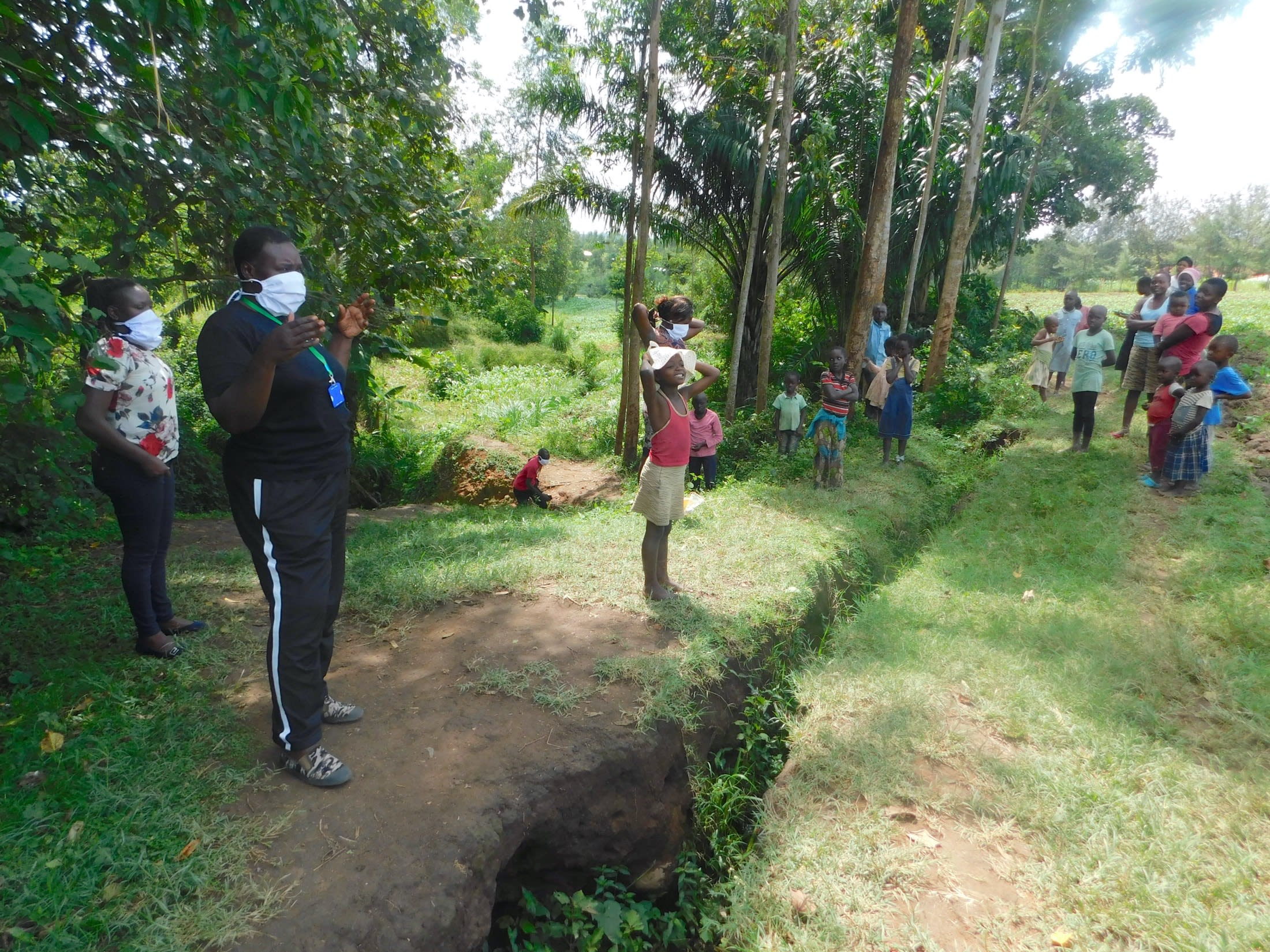
Facilitators (in masks) lead training
We are carrying out awareness and prevention trainings on the virus in every community we serve. Very often, our teams are the first (and only) to bring news and information of the virus to rural communities like Mungakha, Kenya.

Community members observe social distancing as a requirement of attending training
We trained more than 15 people on the symptoms, transmission routes, and prevention of COVID-19. Due to public gathering concerns, we worked with trusted community leaders to gather a select group of community members who would then relay the information learned to the rest of their family and friends.

Team Leader Emmah leads a handwashing demonstration
We covered essential hygiene lessons:
- Demonstrations on how to build a simple handwashing station
- Proper handwashing technique
- The importance of using soap and clean water for handwashing
- Cleaning and disinfecting commonly touched surfaces including at the water point.

Trainer Lynnah demonstrates handwashing at the new leaky tin
We covered COVID-19-specific guidance in line with national and international standards:
- Information on the symptoms and transmission routes of COVID-19
- What social distancing is and how to practice it
- How to cough into an elbow
- Alternative ways to greet people without handshakes, fist bumps, etc.
- How to make and properly wear a facemask.
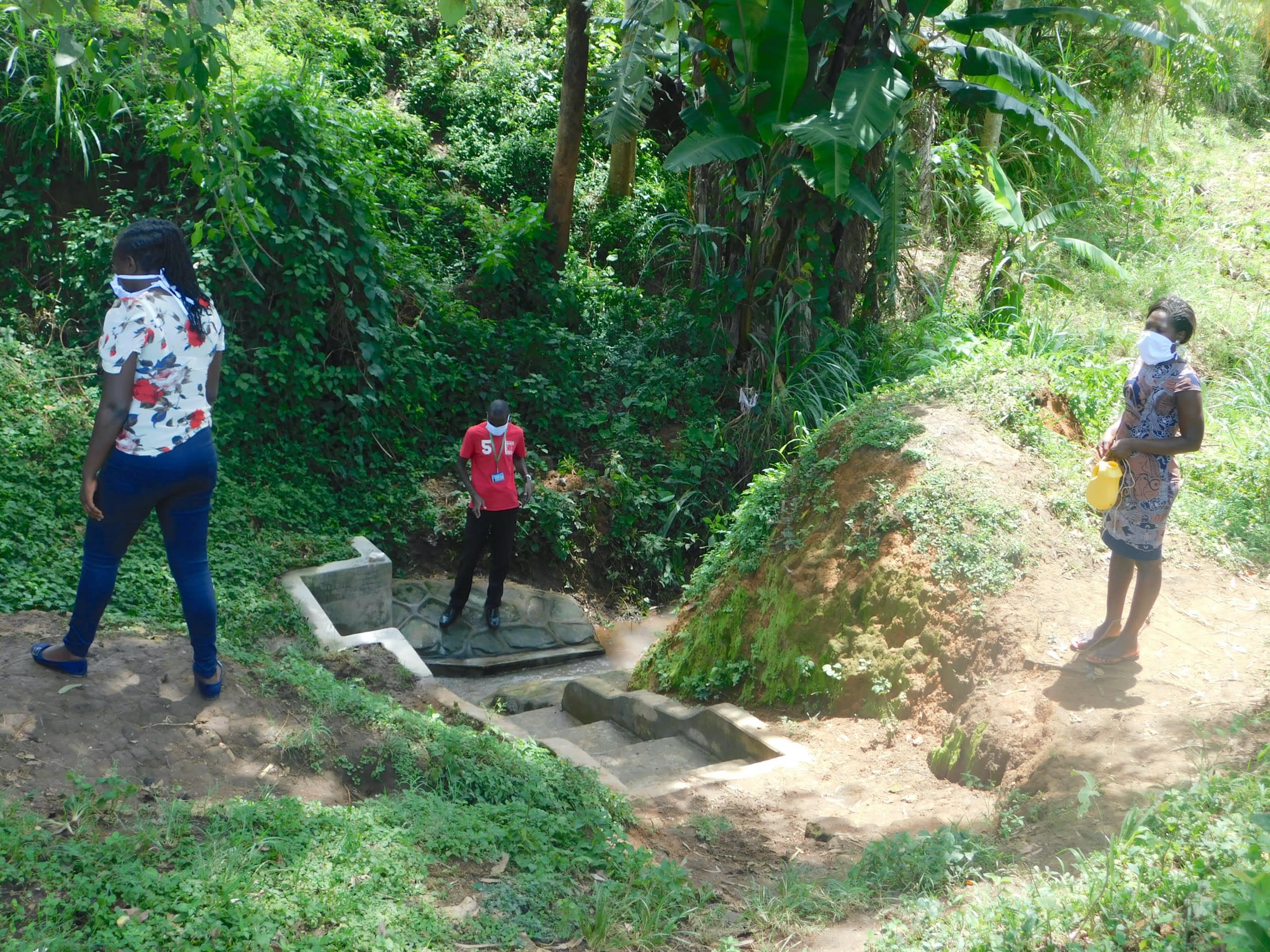
Trainers demonstrate how to maintain social distancing while waiting to fetch water at the spring
During training, we installed a new handwashing station with soap near the community’s spring, Due to the rampant spread of misinformation about COVID-19, we also dedicated time to a question and answer session to help debunk rumors about the disease and provide extra information where needed.

A community member washes her hands
We continue to stay in touch with this community as the pandemic progresses. We want to ensure their water point remains functional and their community stays informed about the virus.

A young girl washes her hands
Water access, sanitation, and hygiene are at the crux of disease prevention. You can directly support our work on the frontlines of COVID-19 prevention in all of the communities we serve while maintaining their access to safe, clean, and reliable water.

November, 2019: Giving Update: Mungakha Community, Asena Spring
A year ago, your generous donation helped Mungakha Community in Kenya access clean water.
There’s an incredible community of monthly donors who have come alongside you in supporting clean water at Asena Spring in Mungakha. Month after month, their giving supports ongoing sustainability programs that help this community maintain access to safe, reliable water. Read more…

January, 2019: Mungakha Community, Asena Spring Project Complete
Mungakha Community is celebrating their new protected spring, so celebrate with them! Asena Spring has been transformed into a flowing source of water thanks to your donation. The spring is protected from contamination, five sanitation platforms have been provided for the community, and training has been done on sanitation and hygiene.
New Knowledge
After completion of the spring protection, we communicated with our contact person and identified the day and time for hygiene and sanitation training sessions. Attendance was great and everyone was eager to learn. Since the training took place during school holidays we even had children at the training, giving us a total number of 24 participants.

It was a sunny day so the training was conducted just near Asena Spring under a tree with nice shade, with a good breeze and quiet surroundings. All the participants were very interested in training, asking questions and also answering questions whenever they were asked.
Several topics were covered during the training, such as personal and environmental hygiene; common local diseases and their prevention; care of the water point. The ten steps of handwashing were demonstrated, along with demonstrations for dental hygiene and water treatment.
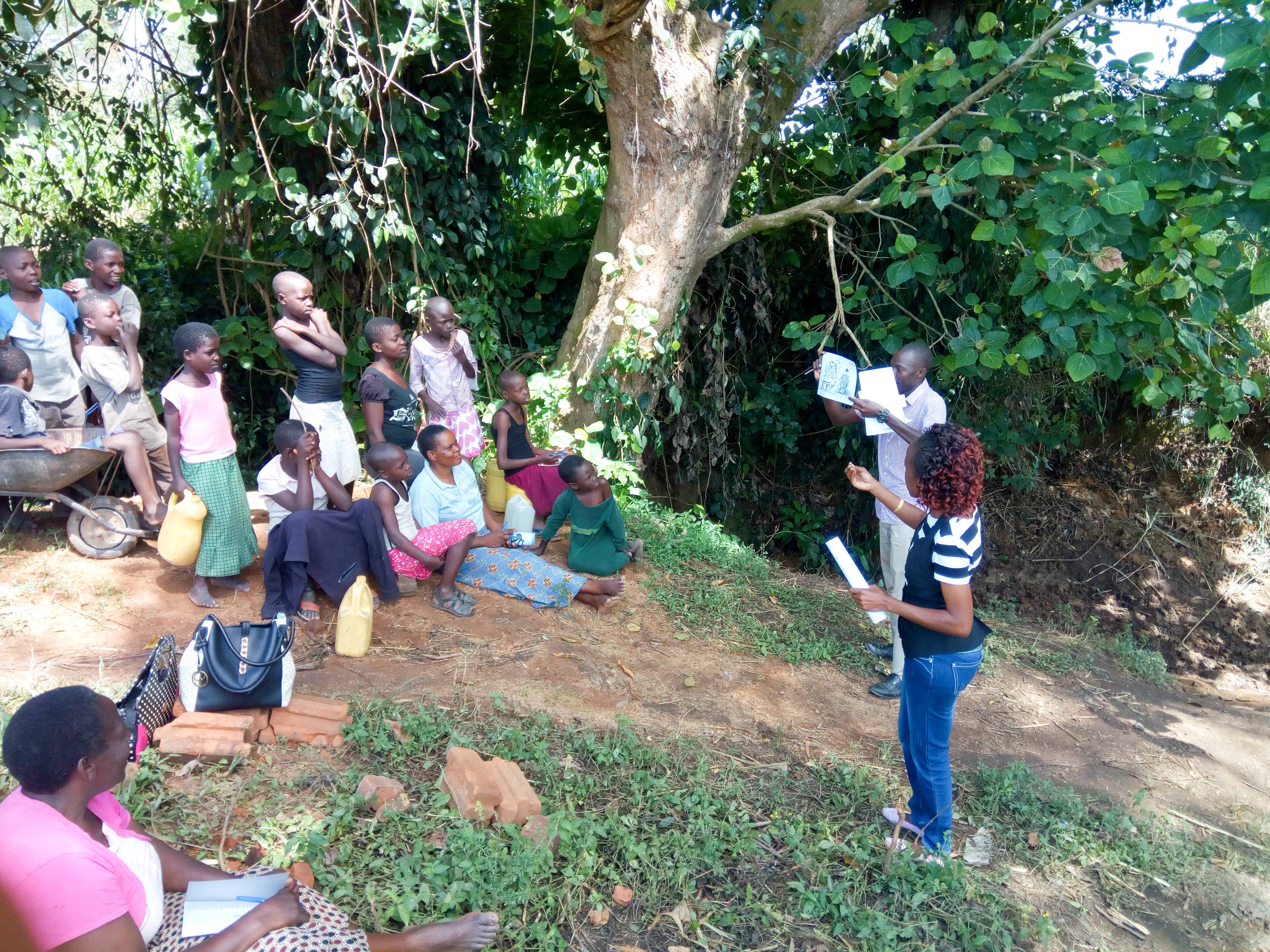
''We have been taking water without precautions, but through this training, it will help us improve on our sanitation and hygiene. Also, you have helped us through training on what we can do to improve on our living," said Philip.
Sanitation Platforms
All five sanitation platforms have been installed and make wonderful, easy to clean latrine floors. These five families are happy about this milestone of having a latrine of their own. We are continuing to encourage families to finish building walls and roofs over their new latrine floors.
Spring Protection
Construction at Asena Spring was successful and water is now flowing from the discharge pipe.
''Before the protection of this spring, I was wondering now 'how can it be protected?' until when I came here after it was complete and I realized that truly God gave people the knowledge to make things a reality which seems to be impossible," said Mrs. Josephine Bulima.
"I am very happy that out of impossibility the reality is here with us and now we drink safe and clean water."

The Process:
Community members provided all locally available construction materials, e.g bricks, wheelbarrows of clean sand, wheelbarrows of ballast, and gravel. Community members also hosted our artisans for the duration of construction.

Children who volunteered to help the artisan during school vacation.
The spring area was excavated with jembes, hoes, and spades to create space for setting the foundation of polyethylene, wire mesh, and concrete.
After the base had been set, both wing walls and the headwall were set in place using brickwork. The discharge pipe was fixed low in place through the headwall to direct the water from the reservoir to the drawing area.

As the wing walls and headwall cured, the stairs were set and ceramic tiles were fixed directly below the discharge pipe. This protects the concrete from the erosive force of the falling water and beautifies the spring. The process of plastering the headwall and wing walls on both sides reinforces the brickwork and prevents water from the reservoir from seeping through the walls and allows pressure to build in the collection box to push water up through the discharge pipe.
The source area was filled up with clean stones and sand and covered with a polyethylene membrane to eliminate any potential sources of contamination.
The concrete dried over the course of five days. With this spring now handed over to the community, we will continue to follow up with the water committee to make sure everything runs smoothly.
Community members who attended training have already taken the initiative to plant grass around the area and build a fence around the water point. People are filling their containers easily and quickly. They are positive that this spring protection coupled with their knowledge of water treatment will keep them from typhoid, cholera, and other issues they dealt with on a regular basis. Clean, accessible water will ensure good health, energy, and time spent on education, economic activities, and family.

December, 2018: Mungakha Community Project Underway
Dirty water from Asena Spring is making people in Mungakha Community sick. Thanks to your generosity, we’re working to install a clean water point and much more.
Get to know your community through the narrative and pictures we’ve posted, and read about this water, sanitation and hygiene project. We look forward to reaching out with more good news!

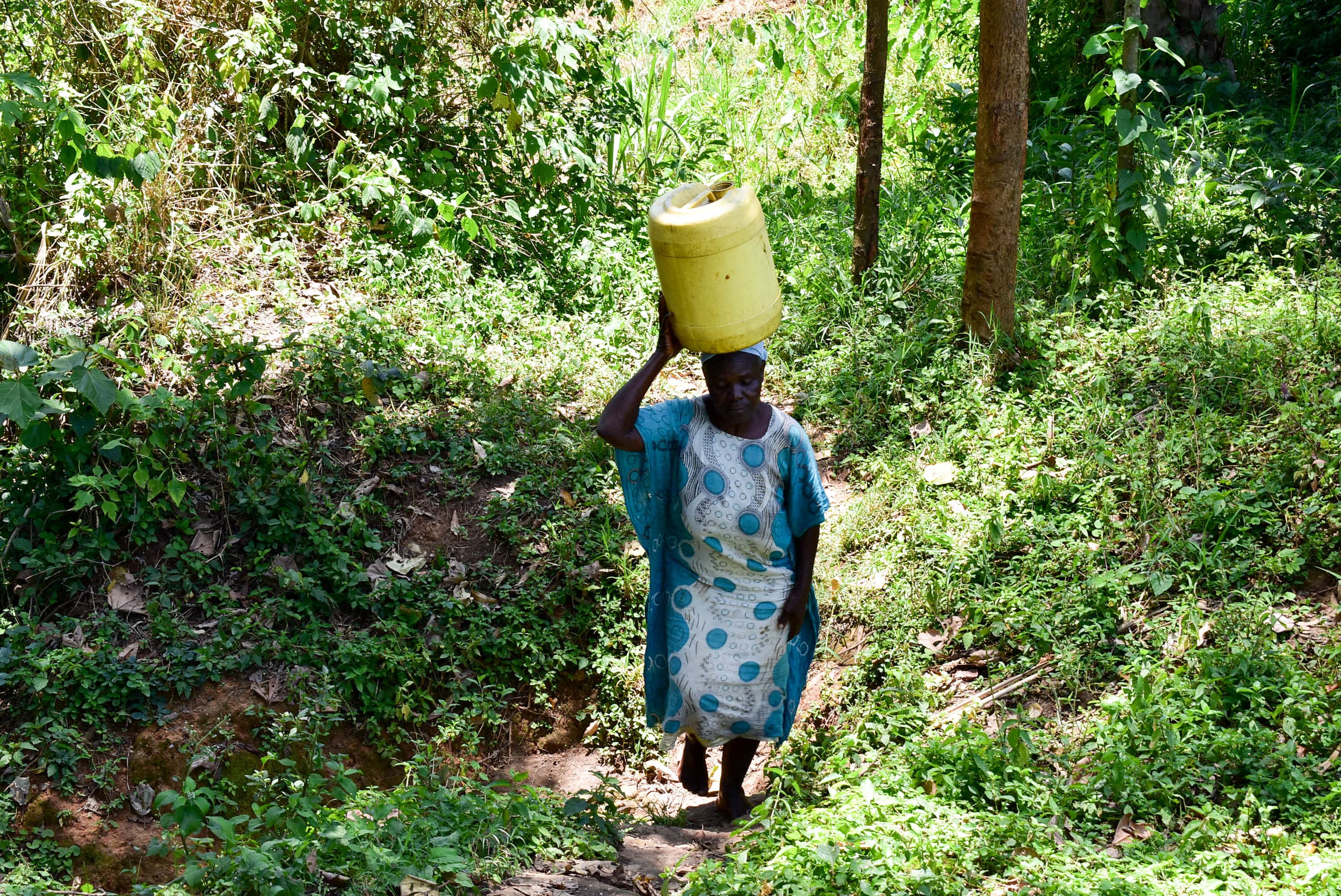

 Protected Spring
Protected Spring
 Rehabilitation Project
Rehabilitation Project










